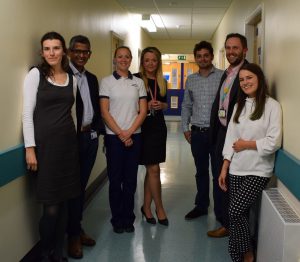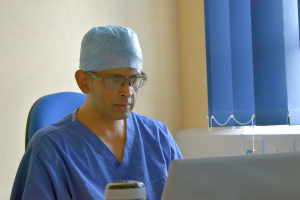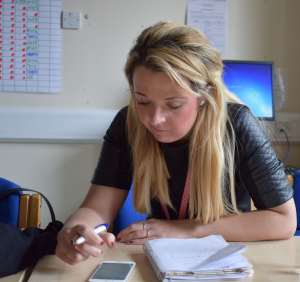by: Sophia Hashim
General
MIRA is currently undergoing two large randomised control trial studies, one focused on adults with musculoskeletal (MSK) disorders, and another studying the effect of using MIRA on falls prevention.
The research project- A Multi-centre, Randomised, Controlled Study Comparing Gamification With Remote Monitoring Against Standard Rehabilitation, for Patients After Arthroscopic Subacromial Decompression Surgery (GAME) is currently being led by Central Manchester University Hospitals NHS Foundation Trust – the study sponsor.
The aim is to develop and validate MIRA as a clinical tool, to replace the traditional clinic-based assessments, with assessment and exercise rehabilitation being carried out in the patient’s home or a non-hospital healthcare setting using the web-enabled Microsoft Kinect device.
Should a system like MIRA show strong benefits to patient recovery, this would allow a large part of care to be delivered in patients’ homes; decreasing the need to travel to and from the hospital. This has the potential to change the way physiotherapists provide care for their patients and empower patients to have a more proactive role in their recovery following orthopaedic surgery.
What is an RCT?
A study design that randomly assigns participants into an experimental group or a control group is called a randomised control study (RCT). Through careful sampling, an attempt is made to avoid different forms of bias to ensure the only difference between the groups is the variable being studied. Randomised controlled trials are the most rigorous way of determining whether a cause-effect relation exists between treatment and outcome and for assessing the cost effectiveness of a treatment. This provides the highest quality evidence in the hierarchy of evidence, and is especially useful when testing new and innovative products such as MIRA. It is useful to provide data to demonstrate the product is able to perform at the same level, or better, than the existing treatments. RCTs generally require significantly more resources than other kinds of studies (i.e. observational studies) and take longer to complete.
The work for the RCT started in 2015, after preparatory work including a range of approvals from regulatory bodies. Patient recruitment started in April 2016 with the aim to reach 90 patients, half in the control group, and half in the treatment group.
For patients entering the trial, each are randomly allocated into either the control or treatment group. Patients in the control group receive the usual treatment for post-shoulder surgery, through exercises suggested by the physiotherapist, whereas the treatment group are additionally offered MIRA therapy. The RCT will provide high quality evidence to demonstrate the efficacy of the MIRA system with a comprehensive set of outcomes collected pre and post intervention, from different domains such as patient reported outcomes, patient engagement with treatment processes and their experience of the care process. This will also establish the safety of the MIRA system in a clinical setting.
“I’m really proud that we can work together so well”- Mr Bibhas Roy
Mr Bibhas Roy is an orthopaedic surgeon specialising in the elbow and shoulder. As the clinical lead for the trial, he is a crucial part of implementing the technology and spearheading the research. He and his team of half a dozen clinicians are responsible for ensuring the trial runs to a high standard, including ethics approval, proper randomisation, and following patients through their treatment. He describes his team as a family, and is really proud of the success they have achieved by working together.
When it comes to the challenges of running such a large scale RCT, Mr. Roy has a very practical approach:
“Whatever in front of you is the main challenge (…), this is what we have to fix now, the rest we will come to. We’re not going to stop, we’re going to get this done and it will happen, we know that. Whatever challenges come our way, we will do it. And half the fun is in that.”
When asked about his reasoning to work with MIRA in particular, his response was very simple: that we listen. He continued on to say
“I get people coming all the time, selling this and saying ‘look we’ve got something that’s really good, take it’. People do not really understand another person’s point of view, they really believe in their heads that what they’ve got is very good and that it doesn’t need changing.”
One of the key strengths of MIRA is to continue to improve the product once it has been purchased by the clients, and believing that such a high quality product can be improved using the input of patients and healthcare professionals.

Online Data & Remote Monitoring
Remote monitoring is a key feature of MIRA whereby a physiotherapist is able to create a personalised exercise schedule to send to the patient to be played at home. Once the patient has used MIRA, data from the session, such as time spent, involvement, repetitions, etc. is synchronised and is available to the therapist. This ensures a constant communication between the patient and the physiotherapist, despite MIRA being used in the comfort of the patient’s home.
In order to ensure Data Protection laws are complied with, secure encryption systems have been developed, along with staff education programmes. These are necessary steps to ensure the implementation of EU/WPR data protection regulations, and guarantee a strong data privacy system. The transfer of information between the hub and patients over the internet was given careful consideration in the design phase, and complies with requirements from NHS Information Governance.
More about the Trial
Patient recruitment is continuing with 10 patients currently in the clinical trial. The NHS Health Research Authority has approved the trial which makes it possible for all NHS organisations to take part. Two other local hospitals – Salford Royal Foundation Trust and Royal Bolton Foundation Trust are due to start recruiting in the near future. The recruitment process involves a brief training to ensure patients know how to use it when they take it home.
Amy Barratt is an Industry Research Facilitator/Nurse and part of the team in Manchester, helping to get the patient started using the technology. “We switch it on, log in, and create username and password for the patients to use the MIRA software. Then we go through the simple training steps to allow the patients to use it so we can see that the patient knows how to use the system.” Being able to use and understand the system first is essential, as it allows patient engagement and interaction with MIRA to be measured accurately.
For the patients randomised to the control group, Amy clarifies: “the controls have normal physiotherapy, so will just do the normal exercises. And they’ll get a diary, so we’re measuring their engagement as well, in both arms of the study”.
Each patient from the MIRA group undergoes a personalised exergames treatment plan for 12 weeks, which is adapted to their needs and the physiotherapists’ clinical decisions. Initially, the patients start with an easy set of exergames, which then increase in difficulty as their movement capabilities get better.
Medicine keeps integrating more and more innovation and technology, and what we do seems to be one of the next steps forward. “We were writing things with a piece of paper and pen not so long ago, now we type things.” Says Mr Roy.
 Mr Bibhas Roy is a specialist shoulder and elbow surgeon, working in the Manchester Orthopaedic Centre, part of the Central Manchester University Hospitals NHS Foundation Trust. His special clinical interests in Tennis Elbow and complex rotator cuff surgery were developed after completing a 12-month shoulder and elbow Fellowship at the Nottingham Shoulder Unit.
Mr Bibhas Roy is a specialist shoulder and elbow surgeon, working in the Manchester Orthopaedic Centre, part of the Central Manchester University Hospitals NHS Foundation Trust. His special clinical interests in Tennis Elbow and complex rotator cuff surgery were developed after completing a 12-month shoulder and elbow Fellowship at the Nottingham Shoulder Unit.
Around 80% of Mr Roy’s surgery is performed using keyhole techniques, and his other work includes participating in the outpatient clinic. Most of his work is performed as day surgery, ensuring a quicker patient recovery time than conventional surgery.
He is an Honorary Senior Lecturer for Salford University, teaching in the Musculoskeletal courses offered by the university, and a member of the Orthopaedic Specialist Training committee in the North West Deanery. Mr Roy also featured on Health Service Journal’s inaugural Top Healthcare Innovators List in 2013. For further details, please see his website.
 Amy Barratt is an Industry Research Facilitator/ Nurse working for the National Institute for Health Research Greater Manchester Clinical Research Network. She is involved in a number of clinical trials, including the co-ordination of multiple research studies, from feasibility/site-initiation, IRAS submissions, recruitment, and follow up to close-out.
Amy Barratt is an Industry Research Facilitator/ Nurse working for the National Institute for Health Research Greater Manchester Clinical Research Network. She is involved in a number of clinical trials, including the co-ordination of multiple research studies, from feasibility/site-initiation, IRAS submissions, recruitment, and follow up to close-out.
About the Author:
 Sophia Hashim is a third year medical student at University College London, and is the Sales and Business Development Intern at MIRA Rehab. She has an interest in the role of Digital Health within the NHS, and how it can be integrated with existing treatments to provide the best possible care for patients.
Sophia Hashim is a third year medical student at University College London, and is the Sales and Business Development Intern at MIRA Rehab. She has an interest in the role of Digital Health within the NHS, and how it can be integrated with existing treatments to provide the best possible care for patients.
